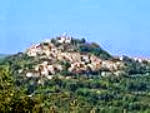The Countryside around the Po River is now a huge expanse of fields, but once was a
vast brughiera of swamps and forests.
The village of Trino, at the crossroad between the old Roman military camps and
the medieval towns of Milan, Turin, Vercelli and Asti, was a sacred forest
called Lucedio (Lucus Dei), where the Cistercian monks settled in 1123 and
built an abbey.
Near the Settlement, there is still a forest - Bosco delle Sorti della Partecipanza di
Trino - managed with sustainable socio-criteria since 1202 and from 1991 a
public park under FSC protection. Elsewhere in the Po Valley, the monks slowly
reclaimed and brought the land under cultivation creating a new
eco-environmental system, the Pianura
Padana.
In the Monferrato area by the Po river, the Pianura
is an expanse of rice fields divided by canals and flooded in spring time, the
so-called Terre d'Acqua, a water-land populated by many migrant animals - herons,
storks, swallows. In between the fields there are many old and unique
farmhouses, the so-called grange,
built by the monks at a distance of half a day’s walk from each other. The
reflections of sun rays and moon lights on the still water that covers the flat
fields design a very particular landscape, which has been also captured by many
artists.
The Parco Fluviale del Po e dell’Orba is a park with conservation and environmental protection of the cultivated lands is assigned to the EcoMuseo delle Terre d’Acqua located in the Antica Riseria San Giovanni, founded in the 15th Century, which preserves the original plant and a 17th Century watermill. It also houses the Museo delle Macchine da Riso.
Palazzo Mossi (Mossi Palace) in Frassineto Po is where the Centro di Interpretazione
del Paesaggio del Po shows environmental changes, the many historical, natural
and geological events which over time have changed the landscape and the
current configuration of the area.
Po River Tours a travel and education
experience for families and groups to discover the history, traditions and
cultures of this major waterway: Boat Tours; Culinary Experiences - wineries,
breweries and local food; Walking, Biking,
Canoeing Horseback Riding; Museums and Cultural Attractions; Accommodations and Transfers.









